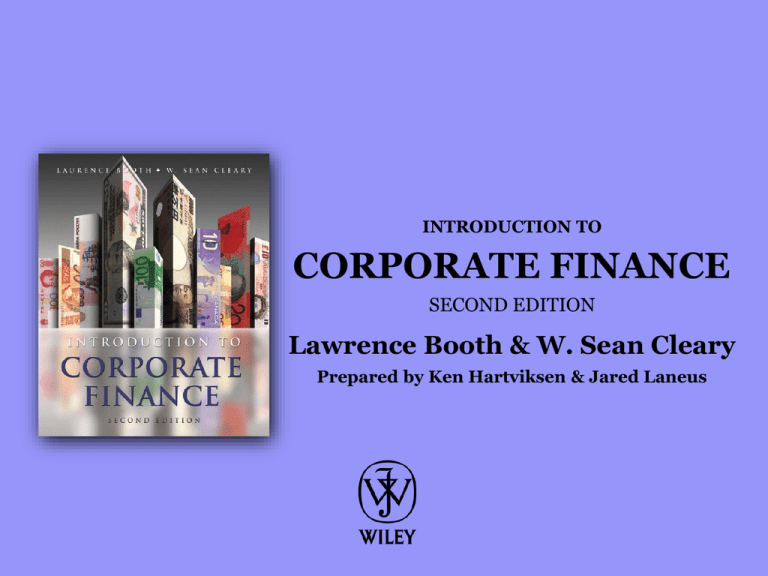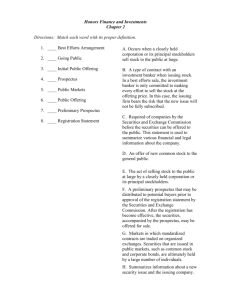
INTRODUCTION TO
CORPORATE FINANCE
SECOND EDITION
Lawrence Booth & W. Sean Cleary
Prepared by Ken Hartviksen & Jared Laneus
Chapter 17
Investment Banking and Securities Law
17.1 Conflicts Between Issuers and Investors
17.2 A Primer on Securities Legislation in Canada
17.3 IPOs and Investment Banking
17.4 Post-IPO Regulation and Seasoned Offerings
2
Booth/Cleary Introduction to Corporate Finance, Second Edition
Learning Objectives
17.1 Explain what is meant by “information asymmetries” and how
these affect the raising of capital.
17.2 Explain the purpose of securities law and regulations in the
financial markets.
17.3 Explain what a prospectus is, what it contains, and why it is
critical for initial public offerings (IPOs).
17.4 Outline the basic steps involved in taking a firm public through
an initial public offering (IPO) of securities.
17.5 Explain why continuous disclosure requirements are important
for investors and how they affect secondary offerings.
3
Booth/Cleary Introduction to Corporate Finance, Second Edition
Conflicts Between Issuers and Investors
Issuers of Securities
• Corporations must issue securities to raise capital in order to invest in
plant, equipment, working capital, research and development in order
to produce products and services that meet needs in a competitive
market environment
• Corporations must design securities that meet the needs of investors
Investors in Securities
• Investors have surplus cash at the moment, but hope to invest the cash
and increase its value
• Some investors have long investment horizons and the capacity to
accept risk (e.g., large pension funds)
• Other investors have shorter investment horizons, require liquid
investments and can only accept minimal risk
4
Booth/Cleary Introduction to Corporate Finance, Second Edition
Conflicts Between Issuers and Investors
•
In addition to issuers and investors, other participants in
the financial markets include:
•
•
•
•
•
Financial intermediaries (e.g., brokers) that bring buyers
and sellers together
Underwriters that help bring new security issues to market
Speculators
Arbitrageurs
Given the diversity of parties, interests, goals, skills and
access to information, the financial marketplace is an
attractive target for scam artists who seek to take
advantage of others.
5
Booth/Cleary Introduction to Corporate Finance, Second Edition
Conflicts Between Issuers and Investors
Asymmetric Information
• Information asymmetries occur when one party in a deal has
more information than another party
• The party with superior information can use that information for
their own benefit at the expense of another party
Implications of Fraud for Financial Markets
• If investors are not convinced that markets are reasonably fair
and that participants obey the law, they will not invest.
• Healthy capital markets are necessary for businesses to have
access to capital so they can invest and create economic growth,
thereby raising peoples’ standards of living.
6
Booth/Cleary Introduction to Corporate Finance, Second Edition
Conflicts Between Issuers and Investors
Examples of Fraudulent Activities
• William Lyons attempting to sell US$220 million of fraudulently
issued zero-coupon bonds to Bear Sterns, Merrill Lynch, Goldman
Sachs and Chase Manhattan
• The use of bearer bonds in Europe
• Ponzi schemes
• Madoff scandal
• Securities dealers dealing in penny stocks through “bucket shops”
• Highly speculative mining and real estate companies issue shares
• “Wash sales” and high pressure sales tactics are used
• The case of Norbourg Asset Management Inc., where its founder
was accused of stealing $84 million of investors money from the
firm he controlled
7
Booth/Cleary Introduction to Corporate Finance, Second Edition
A Primer on Securities Legislation in Canada
Basic Responsibilities
• Under the Canadian Constitution provinces are responsible for
securities regulation
• Many argue that a national securities regulator would improve
the efficiency of Canadian financial markets by harmonizing laws
and their enforcement
• Provincial regulators, like the Ontario Securities Commission,
meet regularly to coordinate efforts through the Canadian
Securities Administrator (CSA)
• The CSA issues national policy statements that provide
recommendations for provincial regulators, and maintains the
System for Electronic Data Access and Retrieval (SEDAR), a
website that publishes information on all publicly-traded
companies in Canada
8
Booth/Cleary Introduction to Corporate Finance, Second Edition
A Primer on Securities Legislation in Canada
What is a Security?
• A security includes “any document, investment or writing
commonly known as a security.”
• The factors considered to determine if a security exists are:
• Whether the promoter raises money and leads the investor to
expect a profit
• Whether the investor has any control on how the money is
spent
• Whether there is risk involved
9
Booth/Cleary Introduction to Corporate Finance, Second Edition
A Primer on Securities Legislation in Canada
Ontario Securities Commission (OSC) Oversight
• Since the largest Canadian stock market, the Toronto Stock
Exchange, is in Ontario, the OSC has considerable
responsibility and influence over securities regulation in
Canada
• The OSC is involved in five major areas where securities are
either transferred or traded:
•
•
•
•
•
Primary market offerings
Secondary market trading
Activities of investment professionals
Insider trading
Takeover bids
10
Booth/Cleary Introduction to Corporate Finance, Second Edition
A Primer on Securities Legislation in Canada
Prospectus Versus Offering Memorandum
• A prospectus is a document in support of a public offering of
securities that must provide “full, true and plain disclosure of all
material information pertaining to the security being issued.”
• A long-form prospectus contains information about the corporate
issuer, directors, financial performance, operations, etc.
• A short-form prospectus contains information about the
particular securities being offered including the price, type of
security, intended use of proceeds, etc.
• An offering memorandum is a disclosure document in support of
an offering of securities in the exempt market, and has the same
objectives of disclosure as a prospectus but offers significantly
less information because of the nature of exempt (i.e.,
sophisticated) investors.
11
Booth/Cleary Introduction to Corporate Finance, Second Edition
IPOs and Investment Banking
• Initial Public Offerings (IPOs) are primary offerings of securities to
the public in a first-time distribution by the issuer which must be
accompanied by a prospectus
• It is difficult to value or price because there is no prior history of
trading in the securities by unrelated parties in arms-length
trading
• Types of public offerings include: best efforts offerings, firm
commitment offerings, bought deals, and standby/rights offerings
12
Booth/Cleary Introduction to Corporate Finance, Second Edition
Motivations for IPOs
• Going public requires a firm to incur significant changes
and costs, including:
• Costs of meeting market listing requirements such as
information disclosure requirements
• Underwriting and distribution costs, e.g., prospectus costs,
underwriter’s spread and any underpricing of the IPO
• Listing fees
• The motivations for going public include:
• Access to capital
• Greater public visibility, which could increase the market
demand for the firm’s products and services
• Providing venture capital firms and entrepreneurs the
opportunity to harvest their investment
• Rewarding managers through options that have a market value
13
Booth/Cleary Introduction to Corporate Finance, Second Edition
IPO Underpricing
• IPO underpricing occurs when the initial offering price of an IPO
is less than its market value on the first day of trading
• Systematic underpricing in occurs in some OECD countries
because of:
• Competition for underwriting business
• Litigiousness of investors
• Spinning, where the underwriter allocates IPOs to favoured clients
knowing they will make a large profit on the first day of trading
14
Booth/Cleary Introduction to Corporate Finance, Second Edition
Post-IPO Regulation and Seasoned Offerings
The Post-IPO Market
• Following the IPO a quiet period is required before the
investment dealer’s research analysts can initiate coverage on the
company, since the prospectus is assumed to provide sufficient
information during the distribution phase.
• Misleading research reports were identified in the U.S. during the
internet bubble of the 1990s and analysts from major U.S.
underwriters were charged for providing these reports.
• Some of the guilty underwriting firms encouraged and rewarded
the practice of providing misleading information because of “selfdealing.” The underwriter had a financial interest in the success
of the security offering and so encouraged its analysts to write
overly positive reports on the security’s prospects.
15
Booth/Cleary Introduction to Corporate Finance, Second Edition
Post-IPO Regulation and Seasoned Offerings
Continuous Disclosure Requirements
• After an IPO investors do not receive a prospectus when
they invest in the securities
• Public companies are expected to become reporting issuers
and provide continuous disclosure, including:
•
•
•
•
Quarterly and annual financial statements
Annual information forms (AIFs)
Proxy and information circulars
Press releases on any material information
• All required information for public issuers in Canada is
available at www.sedar.com
16
Booth/Cleary Introduction to Corporate Finance, Second Edition
Post-IPO Regulation and Seasoned Offerings
Seasoned Offerings and Short-Form Prospectuses
• Reporting issuers in Canada can take advantage of the
annual information form and short-form prospectus (a
system known as the Prompt Offering Prospectus, POP,
system) in order to speed their access to capital markets.
• The short-form prospectus system has given rise to the
use of the “bought deal” in Canada, where the
underwriting contract is signed even before the drafting
of the preliminary prospectus.
• The underwriting market in Canada has become
extremely competitive as information requirements have
been decreased through the POP system.
17
Booth/Cleary Introduction to Corporate Finance, Second Edition
Post-IPO Regulation and Seasoned Offerings
18
Booth/Cleary Introduction to Corporate Finance, Second Edition
Post-IPO Regulation and Seasoned Offerings
19
Booth/Cleary Introduction to Corporate Finance, Second Edition
Copyright
Copyright © 2010 John Wiley & Sons Canada, Ltd. All rights
reserved. Reproduction or translation of this work beyond that
permitted by Access Copyright (the Canadian copyright licensing
agency) is unlawful. Requests for further information should be
addressed to the Permissions Department, John Wiley & Sons
Canada, Ltd. The purchaser may make back-up copies for his or her
own use only and not for distribution or resale. The author and the
publisher assume no responsibility for errors, omissions, or
damages caused by the use of these files or programs or from the
use of the information contained herein.
20
Booth/Cleary Introduction to Corporate Finance, Second Edition





